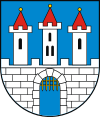Ścinawka Górna
| Ścinawka Górna | |
|---|---|
| Village | |
 Ścinawka Górna | |
| Coordinates: 50°33′N 16°29′E / 50.550°N 16.483°ECoordinates: 50°33′N 16°29′E / 50.550°N 16.483°E | |
| Country |
|
| Voivodeship | Lower Silesian |
| County | Kłodzko |
| Gmina | Radków |
Ścinawka Górna [ɕt͡ɕiˈnafka ˈɡurna] (German: Obersteine) is a village in the administrative district of Gmina Radków, within Kłodzko County, Lower Silesian Voivodeship, in south-western Poland.[1] It lies approximately 8 kilometres (5 mi) north-east of Radków, 18 kilometres (11 mi) north-west of Kłodzko, and 75 kilometres (47 mi) south-west of the regional capital Wrocław.
Prior to 1945 it was in Germany. After World War II the region was placed under Polish administration and ethnically cleansed according to the post-war Potsdam Agreement. The native German populace was expelled and replaced with Poles.
Attractions
The village includes the hamlet of Sarny (German: Scharfeneck) with its imposing 16th-century castle and 19th-century park. The castle, owned for centuries by Czech, Habsburg and then German noblemen, in 1866 was the birthplace of Gustav Adolf von Götzen, German Governor of German East Africa.

